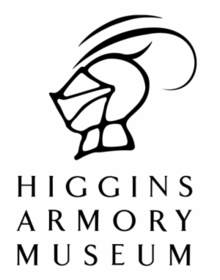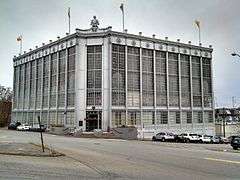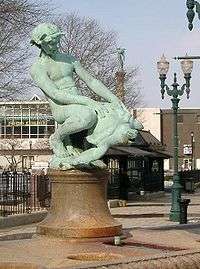Higgins Armory Museum
 | |
 Located in Worcester, Massachusetts | |
| Established | January 1931 |
|---|---|
| Dissolved | 31 December 2013 |
| Location | Worcester, Massachusetts, USA |
| Coordinates | 42°17′50″N 71°47′57″W / 42.297222°N 71.799167°W |
| Type | arms and armor museum |
| Accreditation | American Alliance of Museums |
| Key holdings | 24 full suits of armor[1] |
| Collection size | 2,000 objects[1] |
| Visitors | 60,000 (2012)[2] |
| Director | Suzanne W. Maas |
| Website |
www |
The Higgins Armory Museum was a non-profit museum, located in Worcester, Massachusetts, dedicated to the display of arms and armor. According to the Boston Globe, from its founding in 1931 until 2004 it was "the only museum in the country devoted solely to arms and armor,"[2] and had the second largest arms and armor collection in the country behind the Metropolitan Museum of Art in New York City. The collection consisted of 2,000 objects, including 24 full suits of armor. The museum closed at the end of 2013 due to a lack of funding. Its collection and endowment were transferred and integrated into the Worcester Art Museum, with the collection to be shown in a new gallery slated to open in 2015. The Higgins Armory building was sold in December 2014.[3] The historic structure is believed to be one of, if not the first, building in the U.S. constructed solely out of steel and glass.
History
John Woodman Higgins was a prominent industrialist in Worcester, Massachusetts who owned the Worcester Pressed Steel Company. Higgins traveled to Europe multiple times throughout the 1920s where he collected arms, armor, and other steel items.[2] One of his most important purchases was eight full suits of armor from the collection of George Jay Gould in 1927.[4] Originally, he stored these items in his house, which quickly filled with anything he could find made of steel, from suits of armor to automatic shoe polishers.[5] Higgins incorporated his collection as a museum in 1928,[4] and as the collection grew larger than Higgins' house could hold, he began construction on a steel and glass museum building next to his factory in 1929.[2][5]
"The Museum of Steel and Armor" opened on January 12, 1931,[4] with a grand gala. Music was played by members of the Boston Symphony Orchestra and Higgins' sons dressed in suits of armor.[6] In its original layout, the museum displayed a wide variety of objects constructed of steel including "medieval weaponry, automobile parts, and even ... an all-steel airplane suspended from its ceiling."[5][6] Admission to the museum began with a walk through the armor exhibits and ended with a tour through the production lines to see modern steel manufacturing.[5] The production floor was accessed through catwalks connecting the factory and the armory. Higgins invited visitors to the museum across these catwalks, and he also invited his workers to visit the museum on breaks to get inspired.[7] Higgins died in 1961, leaving the museum a US$17,000 endowment.[2] The museum was first accredited in 1972 by the American Association of Museums and continued operations through the closing of the Worcester Pressed Steel Company in 1975. On January 4, 1978 the museum was the victim of a theft of arms and armor worth over US$100,000.[4]
1979 saw the museum change from a private foundation owned by the Higgins family to a public supported charity. At the vote to incorporate under a public board of trustees, the incorporators turned down offers by the Metropolitan Museum of Art, in New York City, to purchase the collection as well as the offer of a merger with the Worcester Art Museum.[4](Another offer to purchase the collection would come again in 1985, this time from the Museum of Fine Arts in Boston. It too was turned down.)[4] The new museum board rewrote the mission statement, closed the exhibits on modern steel manufacturing, and devoted the museum entirely to ancient and medieval arms and armor.[5] By refocusing the collection, the board created the only museum in America devoted purely to arms and armor.[2][4] The Higgins Armory lost this title in 2004 with the opening of the Frazier Historical Arms Museum in Louisville, Kentucky.[2]
While popular, the Higgins Armory began facing fiscal issues due to a dwindling endowment and inability to raise enough revenue to balance its budget. During the beginning of the 2010s, deficits at the museum ranged between almost US$1,000,000 and US$500,000, draining the already small endowment to US$2,900,000.[2][4] In order to shore up the endowment, the board voted in July 2012 to deaccession more than 500 objects, with the proceeds being put directly into the endowment. When asked about the deaccessioning, Suzanne W. Maas, the museum's interim director, stated "This is simple housekeeping," Maas said. "We have 10 virtually identical examples of troopers helmets. Do we need 10, or do we need seven?"[2]
With the endowment still shrinking, a vote was taken by the trustees in November 2012 to integrate the museum into the Worcester Art Museum. The vote passed and in March 2013, it was announced that the museum would close the end of that year.[4] Suzanne W. Maas stated "There is not enough long-term support, and I can say I am very gratified that the trustees have made the tough decision and did not draw it out."[4] The museum closed on December 31, 2013, and now its entire inventory as well as its endowment have been transferred and integrated into the Worcester Art Museum, located less than 3 miles away. An exhibit of highlights of the Higgins collection is on view, and the art museum will renovate its current library to house the collection permanently. The new gallery is slated to open in 2015.[2][4] It is still unknown what will be done with the Higgins Armory building.[4]
Architecture
|
Higgins Armory Museum | |
|
Higgins Armory Museum | |
| Location | 100 Barber Ave., Worcester, Massachusetts |
|---|---|
| Area | 20,000 sq. ft. |
| Built | 1930 |
| Architect | Leland,Joseph D. |
| Architectural style | International Style |
| MPS | Worcester MRA |
| NRHP Reference # | 80000514[8] |
| Added to NRHP | March 05, 1980 |
The Higgins Armory Museum building was constructed between 1929 and 1931 specifically to hold Higgin's collection of arms and armor in a museum setting.[2][5] The 4 story, L-shaped, Art Deco building was designed by Joseph D. Leland, based out of Boston, Massachusetts.[6] The steel framed building with large expanses of glass cost over 300,000 dollars to construct, and is believed to be one of, if not the first, building in the U.S. constructed solely out of steel & glass.[6][9] The building is L-shaped, with the corner chamfered. The entrance is located on this chamfer, and a large half suit of armor sits on the roof of here as well. The exterior consists of visible steel pilasters, decorated with oversized rivets, dividing sections of glass windows along the sides of the building. A decorative band of steel sits above the first story windows and a row of large medallions sits on the cornice. Originally the first two floors of the building were for offices & the upper two housed the museum.[9]
The main hall inside the building stands in sharp contrast to the exterior. The interior walls of the main galleries were constructed of plaster on metal lathe,[6] and the whole space designed to resemble Prince Eugene of Savoy's Hohenwerfen Castle in Austria, where a selection of works in Higgin's collection came from.[9] The walls were finished to resemble the Gothic stone arches in the medieval castle.[6] Medieval style lighting fixtures can be found throughout the building.[9]
In 1980, the museum was listed on the National Register of Historic Places, and since then there have been two renovation completed. The 1988 renovation cost 1.4 million dollars, followed by another in and 1992 which used 2.6 million dollars raised in campaign.[4][6][10]
Collection
The Higgins collection consists of 2,000 objects, making it the second largest arms and armor collection in the country behind the Metropolitan Museum of Art in New York City. The collection includes 24 full suits of armor, a gladiator helmet, and "Helmutt," a dog mannequin dressed in reproduction boarhound armor. The oldest object in the collection is an Eastern Mediterranean dagger from between 3000 - 1500 B.C.E.[1]
The collection includes gladiator and "Corinthian" helmets, gauntlets from the Renaissance period, and the helmet of a 19th-century French cuirassier. There are also pieces that depict the courtly life - helmets for jousting tournaments, a crossbow for hunting, a ceremonial gorget, and an anvil that was used to manufacture such pieces.
There are knives and axes from Africa, bow case covers from ancient Islam, a horned kulah khud (helmet) from India, and samurai armor from Japan, among others. The collection also includes examples of armor for dogs and horses. There are also full-scale models of jousts and foot tourneys.
- Maximilian field armor with visor for ceremony and tournament, south Germany, 1510-1520
- Helmet embossed in the form of a conch shell (awabi uchidashi kabuto), Japan, 1618. Made by Nagasone Tojiro Mitsumasa; signed "Echizen no kuni ju Mitsumasa; Nagasone Tojiro saku"
- Folding spetum, Italy, c. 1550; once owned by the Rothschild family.
- Carabinier armor, France, 1863-1865
- Reproduction field armor of Archduke Siegmund of Austria 1485 (reproduction 1911-19) with armor for boar hound, German style 16th century, reproduction US 1942. The dog is Higgin's mascot "Helmutt"
Education
The museum was prominent in the local community and hosted a number of educational programs on medieval history and arms and armor, ranging from school workshops and teacher-education to scholarly lectures. The museum hosted school vacation camps as well as medieval festivals and demonstrations of various fighting styles.[6] The museum was a popular location for birthday parties where the cake was sliced by a costumed interpreter with a sword.[10]
The Olive Higgins Prouty Research Library was founded in 1997 with an initial collection of "several thousand books on arms and armor."[4]
The Higgins Armory was a major center of study for Western martial arts. Scholars associated with the museum such as curator Jeffrey Forgeng, William Short, and Ken Mondschein produced monographs and translations, gave papers and sponsored sessions at scholarly conferences, and lectured and demonstrated both in the US and Europe. The Higgins Armory Sword Guild, founded in part by Patri J. Pugliese, was a study group that conducts research into Western martial arts and demonstrates at the museum and in the community. The museum also held historical fencing and martial arts classes.[11]
In popular media
Norman Rockwell drew an imagined scene in the Higgins armory museum, titled Midnight Snack, for the November 3, 1962 cover of The Saturday Evening Post.[12]
Higgins Armory Museum has been featured on the History Channel on multiple occasions, including a special DVD extra that focused solely on the museum.
In April 2011, the TV show Ghost Hunters filmed an episode at the museum to see if the ghost of Mr. Higgins haunted the building.[4]
See also
References
- 1 2 3 "Knight Moves". The Boston Globe. December 1, 2013. Retrieved 24 December 2013.
- 1 2 3 4 5 6 7 8 9 10 11 Edgers, Geoff (March 8, 2013). "Higgins Armory Museum to close". The Boston Globe. Retrieved 31 July 2013.
- ↑ Worcester Magazine (27 December 2014). "Higgins Armory building in Worcester sold to New Hampshire man". Retrieved 22 January 2015.
- 1 2 3 4 5 6 7 8 9 10 11 12 13 14 15 Duckett, Richard (8 March 2013). "Higgins Armory Museum to close after 82 years". Worcester Telegram and Gazette. Retrieved 8 March 2013.
- 1 2 3 4 5 6 "Higgins Armory". Roadside America. December 1, 2013. Retrieved 24 December 2013.
- 1 2 3 4 5 6 7 8 Truman, Malory. "Museum Focus: Higgins Armory Museum". Antiques and Fine Art Magazine. Retrieved 26 December 2013.
- ↑ Silk, Tema. What's Next for Worcester's Higgins Armory Museum?. New England Public Radio. 13 December 2013. Retrieved December, 26, 2013.
- ↑ National Park Service (2009-03-13). "National Register Information System". National Register of Historic Places. National Park Service.
- 1 2 3 4 Lavoie, Catherine (February 1989). "Higgins Armory" (PDF). Historic American Buildings Survey. Washington, D.C.: Library of Congress. p. 1. Retrieved February 24, 2014.
- 1 2 Edgers, Geoff. Founder's kin fights to stop Higgins Armory's closure. The Boston Globe. 27 March 2013. Retrieved 27 December 2013.
- ↑ "Higgins Armory Academy of the Sword". Archived from the original on March 5, 2013.
- ↑ Denny, Diana. "Rockwell in the 1960s – Part II". The Saturday Evening Post online. Retrieved 26 December 2013.
External links
 Media related to Higgins Armory Museum at Wikimedia Commons
Media related to Higgins Armory Museum at Wikimedia Commons- Classical fencing and historical swordsmanship classes at the Higgins
- Historic American Buildings Survey (HABS) No. MA-1236, "Higgins Armory, 100 Barber Avenue, Worcester, Worcester County, MA", 16 photos, 3 color transparencies, 1 data page, 2 photo caption pages
- SaveHiggins.org - group trying to stop the closure of the museum


